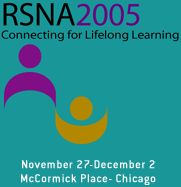
Abstract Archives of the RSNA, 2005
SSK02-06
Correlation of Superficial Femoral Artery Occlusive Disease Severity with MR Cine Phase Contrast Flow Measurements
Scientific Papers
Presented on November 30, 2005
Presented as part of SSK02: Vascular/Interventional (MR Angiography)
Kiyarash Mohajer MD, Presenter: Nothing to Disclose
Honglei Zhang MD, Abstract Co-Author: Nothing to Disclose
Daniel S. Gurell MD, Abstract Co-Author: Nothing to Disclose
Hale Ersoy MD, Abstract Co-Author: Nothing to Disclose
Bernard Ho, Abstract Co-Author: Nothing to Disclose
Martin R. Prince MD, PhD, Abstract Co-Author: Nothing to Disclose
Craig Kent MD, Abstract Co-Author: Nothing to Disclose
et al, Abstract Co-Author: Nothing to Disclose
To evaluate if cine phase contrast (PC) flow data across stenoses can predict atherosclerotic lesion severity.
48 patients underwent 3D Gd enhanced MRA followed by 2D axial cine PC above and below the site of greatest SFA disease severity. All imaging was performed on a 1.5 T GE signa EXCITE system. PC imaging parameters included TR/TE/flip=6.9/3.3/30; FOV=32 cm; slice thickness=6mm; matrix=256 x 256; gradient moment nulling; views per segment=4 with reconstruction of 20 images spanning the R-to-R interval; velocity encoding was set 100cm/s with acquisition flow direction S/I. Cine PC flow measurements were also obtained in 9 healthy volunteers at the level of proximal SFA/PFA and at the level of the popliteal artery. Phase contrast data were post-processed on the advantage windows workstation using Medis flow analysis software to obtain flow velocity and flow volume curves above and below the lesion of greatest severity. The ratios of peak velocity and flow volume above to below lesion and the incidence of time delay to peak velocity below lesion were calculated and the pattern of change in the shape of flow curves was observed. These flow parameters were correlated with lesion severity.
From 96 arterial segments in 48 patients, 26 were normal or mildly stenotic, 35 had moderate-to-severe stenosis and 35 were occluded. The mean peak flow velocity above/below lesion was significantly higher in the segments with severe disease (1.9,p=0.04) or occlusion (2.0,p=0.01) compared to the vessel segments of normal volunteers (1.4). Observation of a delay in peak velocity below lesions showed significant positive correlation with lesion severity (r=0.69, p<0.001). Mean flow volume above/below lesion was 3.9 in occluded vessels versus 2.3 in normal volunteers (p=0.04). The flow curves tended to change from triphasic to bi- or monophasic below mod-severe stenoses (21 of 35) and occlusions (33 of 35).
Changes in flow parameters across peripheral vascular lesions correlate with severity. This may help determine which lesions are hemodynamically significant obviating the need for invasive pressure gradient measurements.
Mohajer, K,
Zhang, H,
Gurell, D,
Ersoy, H,
Ho, B,
Prince, M,
Kent, C,
et al, ,
Correlation of Superficial Femoral Artery Occlusive Disease Severity with MR Cine Phase Contrast Flow Measurements. Radiological Society of North America 2005 Scientific Assembly and Annual Meeting, November 27 - December 2, 2005 ,Chicago IL.
http://archive.rsna.org/2005/4408259.html

